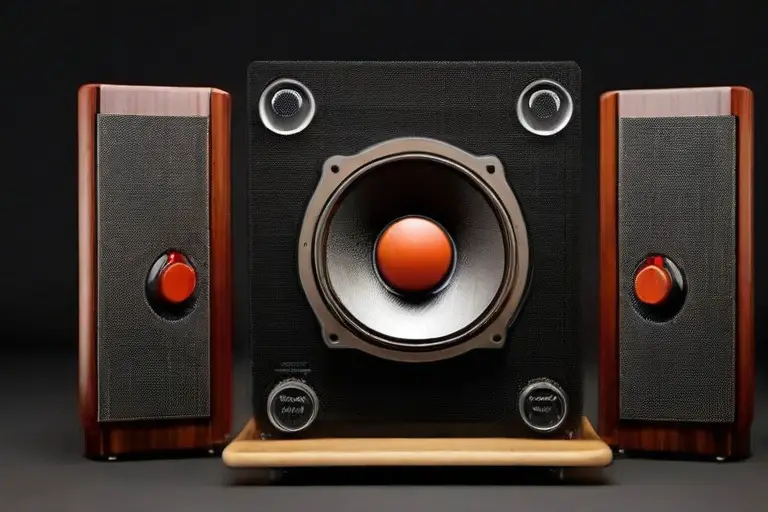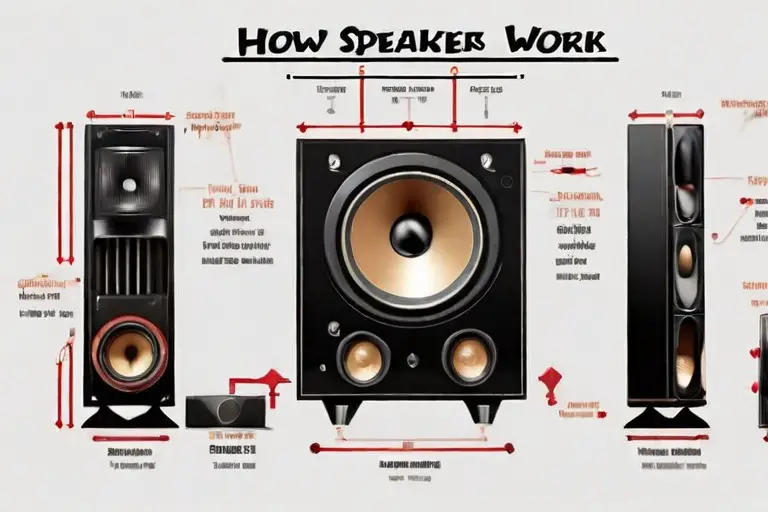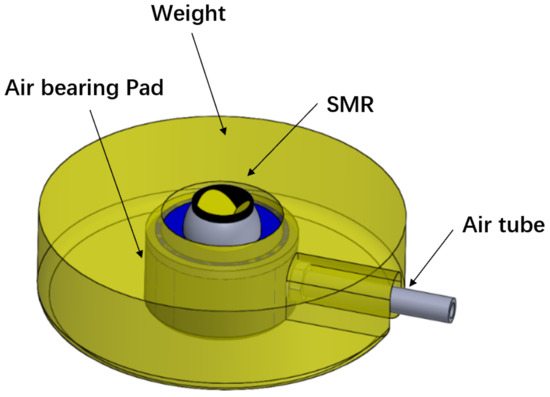Do you know how your speakers work? If not, don’t worry – you’re not alone. In fact, many people don’t even realize that there are different types of speakers and how they work. But if you’re interested in learning more about this topic, read on for a basic introduction to speaker function and design. The first thing to understand is that speakers come in all shapes and sizes, but they all have one basic goal: to produce sound.
To do this, they use an electromagnet (a coil of wire that produces a magnetic field when electricity is flowing through it) to move a cone-shaped piece of paper or plastic called a diaphragm. The vibrations of the diaphragm create sound waves that travel through the air and eventually reach your ears.
How Speakers Make Sound
How Do Speakers Work Step by Step?
Speakers are one of the most important components in any audio system, and they come in all shapes and sizes. But how do speakers work? How do they take the electrical signal from your amplifier and turn it into sound? In this blog post, we’ll take a look at how speakers work, step by step. The first step is to understand how an electrical signal can be turned into sound. Sound is simply a pressure wave that travels through the air (or any other medium).
When you speak, your vocal cords vibrate, creating pressure waves that travel through the air to your listener’s ear. Similarly, when an amplifier drives a speaker, it produces an electrical signal that causes the speaker cone to vibrate. This vibration creates pressure waves that travel through the air just like your voice does.
The second step is to understand how a speaker converts an electrical signal into sound. A speaker consists of three main parts: a magnet, a coil of wire, and a cone (or diaphragm). The magnet is usually located at the center of the speaker cone (although some designs place it outside). The coil of wire is wrapped around the magnet. And finally, the cone (or diaphragm) is attached to the coil of wire. When there’s no music playing, the magnet and coil are both stationary.
But when music begins playing, electricity flows through the coil of wire and causes it to move back and forth inside the magnetic field created by the magnet. As it moves back and forth, it pushes and pulls on the cone (or diaphragm), causing it to vibrate. It’s this vibration that produces sound waves – just like your vocal cords produce sound waves when you speak!
The third step is to understand how different types of speakers work. There are two main types of speakers: dynamic speakers and electrostatic speakers. Dynamic speakers are by far the most common type – they’re what you’ll find in almost all home stereo systems, as well as car stereos and portable radios/boom boxes.
Electrostatic speakers are less common but offer superior sound quality; they’re often used in high-end home stereo systems and professional audio applications such as recording studios or movie theaters. Dynamic Speakers:
Dynamic speakers consist of three main parts: 1) Magnet, 2) Coil

What are the 3 Parts of a Speaker?
When most people think of a speaker, they think of the person who is speaking. However, there are actually three parts to a speaker: the source, the medium, and the destination. The source is the person or thing that is producing the sound. The medium is the material that is carrying the sound. The destination is the person or thing that is receiving the sound.
What are the 4 Parts of a Speaker?
A speaker is an electroacoustic transducer that converts electrical energy into sound waves. The four main parts of a speaker are the cone, the coil, the magnet, and the frame. The cone is made of paper, plastic, or metal and attaches to the coil. The coil is a wire that is wrapped around the magnet. The magnet creates a magnetic field that interacts with the coil to create sound. The frame holds all of these parts together.

How Do Speakers Make Different Sounds?
Speakers produce sound by vibrating their cones. The larger the cone, the lower the pitch of the resulting sound. The speed at which the cone vibrates also affects the pitch; faster vibrations produce higher pitches.
When a speaker is connected to an amplifier, it receives an electrical signal that makes the cone vibrate. This vibration causes air molecules to bump into each other, creating sound waves that we hear as music or speech.
Different sounds are produced by varying the shape of the speaker cone and by changing how fast it vibrates.
For example, a drum produces a low-pitched boom because its large, flat surface vibrates slowly. A cymbal produces a high-pitched crash because its small surface area can vibrate very quickly. By altering these two factors – size and speed – speakers can create a wide range of sounds.

Credit: www.mdpi.com
How Do Speakers Produce Sound
How do speakers produce sound? Speakers work by converting electrical energy into mechanical energy. This is done by using a coil of wire (the voice coil) that is wrapped around a permanent magnet. When an electrical current is applied to the voice coil, it creates a magnetic field. This interacts with the permanent magnet, causing the coil to move back and forth.
This movement causes the cone of the speaker to vibrate, which produces sound waves. The frequency of the electrical current determines the frequency of the sound waves that are produced. The amplitude of the current determines how loud the sound will be.
How Speakers Work Animation
How do speakers work? Speakers use a cone-shaped diaphragm that vibrates to produce sound. The larger the cone, the lower the frequency it can reproduce. A speaker’s size is usually a good indicator of its low-frequency response – larger speakers tend to have better bass response. The voice coil is attached to the center of the cone and surrounded by a permanent magnet. When an electrical current flows through the voice coil, it creates a magnetic field.
This interacts with the permanent magnet, causing the voice coil and cone to move back and forth. The movement of the cone produces sound waves in the air, which our ears perceive as sound. Different types of speakers are designed for different purposes. For example, subwoofers are specifically designed to reproduce low frequencies (bass). Tweeters reproduce high frequencies (treble), while mid-range speakers cover everything in between.
Speaker Working Principle Pdf
Understanding speaker working principles can seem like a complex task, but once you grasp the basics, it’s pretty straightforward. So, how do speakers work? A good way to visualize this is through a diagram. The speaker consists of several parts, including a magnet, a voice coil, and a diaphragm or cone.
When an electrical audio signal is applied to the voice coil, it creates a magnetic field that interacts with the speaker’s magnet. This interaction causes the voice coil to move back and forth rapidly, pushing and pulling the attached diaphragm with it. As the diaphragm vibrates, it pushes air molecules around it creating sound waves that we perceive as sound.
This simple yet fascinating process is the crux of all sound system technology. Understanding it not only quenches your thirst for knowledge but may also come in handy when troubleshooting your sound system issues or when you’re in the market for a new set of speakers.
Frequently Asked Questions [FAQs]
What is a speaker diagram?
A speaker diagram is a visual representation of the structure and operation of a speaker. It shows the individual components of a speaker, such as the diaphragm, voice coil, and magnetic field, and illustrates how they work together to produce sound.
What are the main components of a speaker depicted in the diagram?
The main components depicted in a speaker diagram usually include the diaphragm (or cone), voice coil, permanent magnet, suspension, and speaker frame or basket. Some diagrams may also show additional components like the dust cap, surround, and spider.
How does a speaker function as illustrated in the diagram?
In a speaker diagram, the function of a speaker is illustrated by showing how an electrical signal from an audio source is sent to the voice coil, causing it to move back and forth in the magnetic field created by the permanent magnet. This movement is transferred to the diaphragm, causing it to vibrate and produce sound waves that we hear as sound.
What does the diaphragm do in a speaker?
The diaphragm, often made of a flexible material like paper, plastic, or metal, vibrates in response to the electrical signals received from the voice coil. These vibrations create sound waves that travel through the air and are perceived as sound by our ears.
What is the role of the voice coil in a speaker?
The voice coil, usually made of a thin wire wrapped around a bobbin, receives the electrical signal from the audio source. When this current passes through the coil, it interacts with the magnetic field from the permanent magnet, causing the coil and attached diaphragm to move back and forth, creating sound.
Conclusion
How Speakers Work Diagram: Speakers are devices that convert electrical energy into sound. The most common type of speaker uses a paper or plastic cone attached to a metal coil called a voice coil. When the voice coil is energized by an electric current, it creates a magnetic field. This field interacts with the permanent magnet in the speaker, causing the voice coil and cone to vibrate. The vibration of the cone creates sound waves in the air, which our ears perceive as sound.
